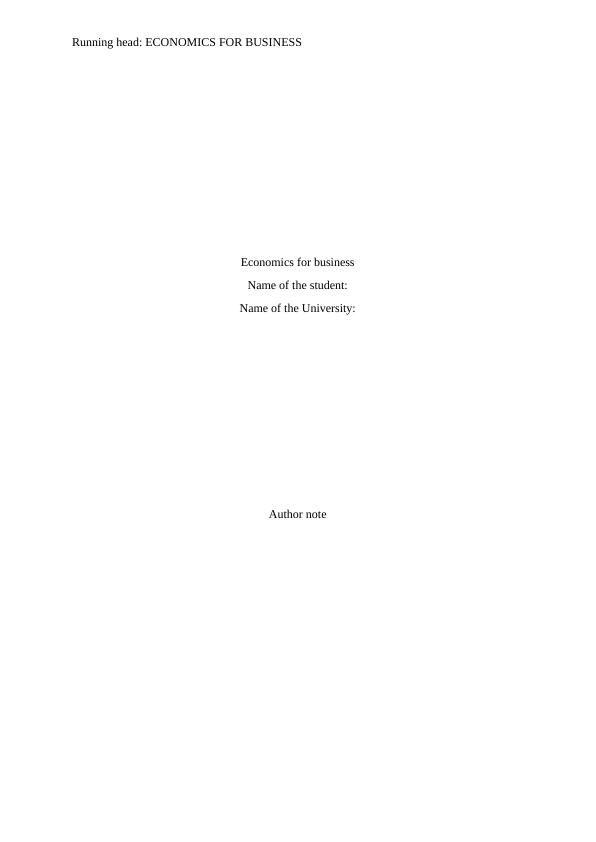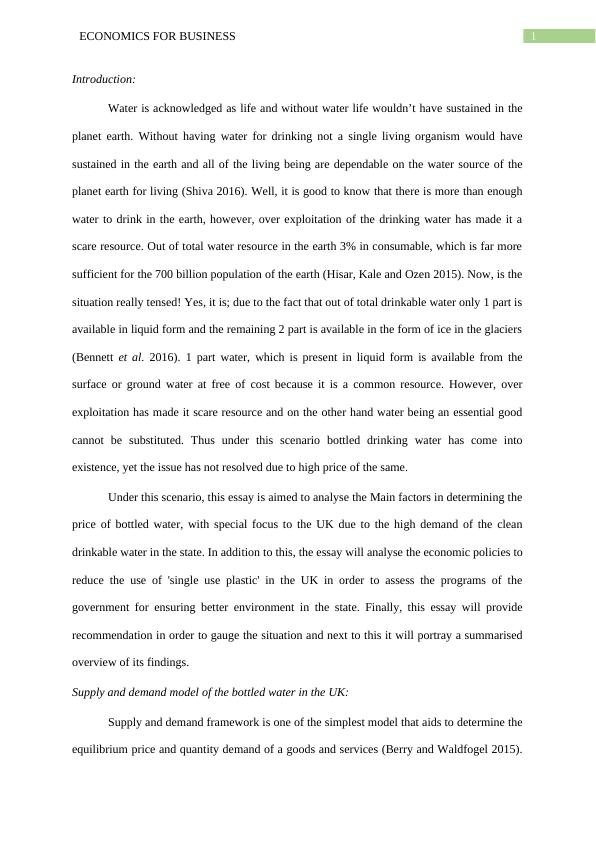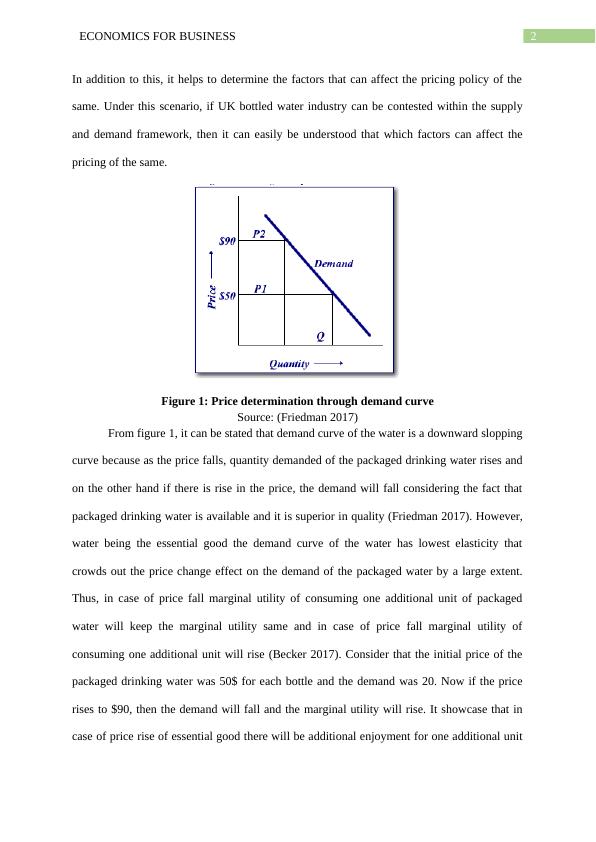Factors Determining the Price of Bottled Water in the UK
Added on 2023-06-14
13 Pages3659 Words362 Views
Running head: ECONOMICS FOR BUSINESS
Economics for business
Name of the student:
Name of the University:
Author note
Economics for business
Name of the student:
Name of the University:
Author note

1ECONOMICS FOR BUSINESS
Introduction:
Water is acknowledged as life and without water life wouldn’t have sustained in the
planet earth. Without having water for drinking not a single living organism would have
sustained in the earth and all of the living being are dependable on the water source of the
planet earth for living (Shiva 2016). Well, it is good to know that there is more than enough
water to drink in the earth, however, over exploitation of the drinking water has made it a
scare resource. Out of total water resource in the earth 3% in consumable, which is far more
sufficient for the 700 billion population of the earth (Hisar, Kale and Ozen 2015). Now, is the
situation really tensed! Yes, it is; due to the fact that out of total drinkable water only 1 part is
available in liquid form and the remaining 2 part is available in the form of ice in the glaciers
(Bennett et al. 2016). 1 part water, which is present in liquid form is available from the
surface or ground water at free of cost because it is a common resource. However, over
exploitation has made it scare resource and on the other hand water being an essential good
cannot be substituted. Thus under this scenario bottled drinking water has come into
existence, yet the issue has not resolved due to high price of the same.
Under this scenario, this essay is aimed to analyse the Main factors in determining the
price of bottled water, with special focus to the UK due to the high demand of the clean
drinkable water in the state. In addition to this, the essay will analyse the economic policies to
reduce the use of 'single use plastic' in the UK in order to assess the programs of the
government for ensuring better environment in the state. Finally, this essay will provide
recommendation in order to gauge the situation and next to this it will portray a summarised
overview of its findings.
Supply and demand model of the bottled water in the UK:
Supply and demand framework is one of the simplest model that aids to determine the
equilibrium price and quantity demand of a goods and services (Berry and Waldfogel 2015).
Introduction:
Water is acknowledged as life and without water life wouldn’t have sustained in the
planet earth. Without having water for drinking not a single living organism would have
sustained in the earth and all of the living being are dependable on the water source of the
planet earth for living (Shiva 2016). Well, it is good to know that there is more than enough
water to drink in the earth, however, over exploitation of the drinking water has made it a
scare resource. Out of total water resource in the earth 3% in consumable, which is far more
sufficient for the 700 billion population of the earth (Hisar, Kale and Ozen 2015). Now, is the
situation really tensed! Yes, it is; due to the fact that out of total drinkable water only 1 part is
available in liquid form and the remaining 2 part is available in the form of ice in the glaciers
(Bennett et al. 2016). 1 part water, which is present in liquid form is available from the
surface or ground water at free of cost because it is a common resource. However, over
exploitation has made it scare resource and on the other hand water being an essential good
cannot be substituted. Thus under this scenario bottled drinking water has come into
existence, yet the issue has not resolved due to high price of the same.
Under this scenario, this essay is aimed to analyse the Main factors in determining the
price of bottled water, with special focus to the UK due to the high demand of the clean
drinkable water in the state. In addition to this, the essay will analyse the economic policies to
reduce the use of 'single use plastic' in the UK in order to assess the programs of the
government for ensuring better environment in the state. Finally, this essay will provide
recommendation in order to gauge the situation and next to this it will portray a summarised
overview of its findings.
Supply and demand model of the bottled water in the UK:
Supply and demand framework is one of the simplest model that aids to determine the
equilibrium price and quantity demand of a goods and services (Berry and Waldfogel 2015).

2ECONOMICS FOR BUSINESS
In addition to this, it helps to determine the factors that can affect the pricing policy of the
same. Under this scenario, if UK bottled water industry can be contested within the supply
and demand framework, then it can easily be understood that which factors can affect the
pricing of the same.
Figure 1: Price determination through demand curve
Source: (Friedman 2017)
From figure 1, it can be stated that demand curve of the water is a downward slopping
curve because as the price falls, quantity demanded of the packaged drinking water rises and
on the other hand if there is rise in the price, the demand will fall considering the fact that
packaged drinking water is available and it is superior in quality (Friedman 2017). However,
water being the essential good the demand curve of the water has lowest elasticity that
crowds out the price change effect on the demand of the packaged water by a large extent.
Thus, in case of price fall marginal utility of consuming one additional unit of packaged
water will keep the marginal utility same and in case of price fall marginal utility of
consuming one additional unit will rise (Becker 2017). Consider that the initial price of the
packaged drinking water was 50$ for each bottle and the demand was 20. Now if the price
rises to $90, then the demand will fall and the marginal utility will rise. It showcase that in
case of price rise of essential good there will be additional enjoyment for one additional unit
In addition to this, it helps to determine the factors that can affect the pricing policy of the
same. Under this scenario, if UK bottled water industry can be contested within the supply
and demand framework, then it can easily be understood that which factors can affect the
pricing of the same.
Figure 1: Price determination through demand curve
Source: (Friedman 2017)
From figure 1, it can be stated that demand curve of the water is a downward slopping
curve because as the price falls, quantity demanded of the packaged drinking water rises and
on the other hand if there is rise in the price, the demand will fall considering the fact that
packaged drinking water is available and it is superior in quality (Friedman 2017). However,
water being the essential good the demand curve of the water has lowest elasticity that
crowds out the price change effect on the demand of the packaged water by a large extent.
Thus, in case of price fall marginal utility of consuming one additional unit of packaged
water will keep the marginal utility same and in case of price fall marginal utility of
consuming one additional unit will rise (Becker 2017). Consider that the initial price of the
packaged drinking water was 50$ for each bottle and the demand was 20. Now if the price
rises to $90, then the demand will fall and the marginal utility will rise. It showcase that in
case of price rise of essential good there will be additional enjoyment for one additional unit

3ECONOMICS FOR BUSINESS
of consumption and contrary to this, if there is price fall, then it will reduce the marginal
utility.
Figure 2: Demand shift
Source: (Friedman 2017)
Now considering this, if there is rise in demand of the packaged drinking water, then
it will lead to shift in the demand curve. And if there is fall in the demand due to change in
the consumer behaviour, personal factors, market structure and others, then it will shift the
demand curve leftward (Pinson and Madsen 2014). From the figure 2, it can be seen that,
under a ceteris paribus situation, if the demand fall from initial D2 position to D1, then the
price will also fall. At price P1, the quantity demanded of the packaged drinking water is Q1,
not the Q2 because supply and demand equilibrium occurs at P1Q1 position. On the other
hand, of the quantity demanded would have been represented by D2, then it would represent
a new equilibrium, where the price and quantity demanded will be higher than the present
P1Q1 position.
of consumption and contrary to this, if there is price fall, then it will reduce the marginal
utility.
Figure 2: Demand shift
Source: (Friedman 2017)
Now considering this, if there is rise in demand of the packaged drinking water, then
it will lead to shift in the demand curve. And if there is fall in the demand due to change in
the consumer behaviour, personal factors, market structure and others, then it will shift the
demand curve leftward (Pinson and Madsen 2014). From the figure 2, it can be seen that,
under a ceteris paribus situation, if the demand fall from initial D2 position to D1, then the
price will also fall. At price P1, the quantity demanded of the packaged drinking water is Q1,
not the Q2 because supply and demand equilibrium occurs at P1Q1 position. On the other
hand, of the quantity demanded would have been represented by D2, then it would represent
a new equilibrium, where the price and quantity demanded will be higher than the present
P1Q1 position.

End of preview
Want to access all the pages? Upload your documents or become a member.
Related Documents
Demand and Supply Factors of Bottle Water in United Kingdom - Reportlg...
|11
|3244
|31
Assessing Public Acceptance of Treated Desalinated Water and Wastewater as Potable Water in Australialg...
|13
|3254
|99
Supply and Demand Analysis Assignmentlg...
|9
|3109
|119
Market Equilibrium and Shifts in Supply and Demand: Economic Analysis of UK Market during Christmas 2021lg...
|15
|3072
|323
ECO511 - Economics for Business || Assignmentlg...
|12
|2771
|136
Impact of Brexit and COVID-19 on the Food Industry in the UKlg...
|16
|3315
|92
